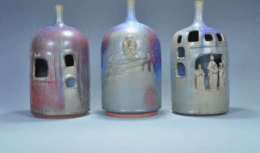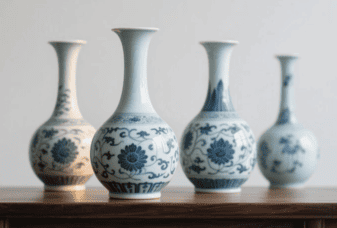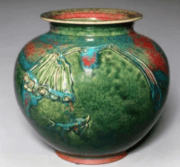Ming Chenghua year porcelain auction storm: sky-high price of 280 million Hong Kong dollars!
- In 2014, Sotheby’s Hong Kong spring auction site, a less than the size of the palm of the Ming Chenghua doucai chicken bowl cup hammer hammer set, set a new record for Chinese porcelain auction.
- The buyer, Shanghai collector Liu Yiqian, used this “treasure in the palm of his hand” to drink tea, making the Ming Chenghua porcelain once again become the focus of the global art market. As the pinnacle of the Ming dynasty porcelain on behalf of the official kilns of Chenghua wares every appearance on the auction block, are rewriting history at the same time, unveiling a period of royal aesthetics, craft code and the capital of the legend of the game.

Chenghua porcelain is the porcelain fired in the official kilns of Jingdezhen during the Chenghua period (1465-1487) of the Ming Dynasty, and is known for its light and thin body, warm glaze, and fine painting. In particular, Chenghua doucai porcelain is regarded as the pinnacle of Chinese ceramic history.
First, Chenghua porcelain price gene: technology, scarcity and historical narrative
- Chenghua porcelain can be stable at the tip of the pyramid of Chinese art auction, and its “three great” qualities are inseparable. Tire such as jade, glaze, colorful and subtle craft standards, in the Chenghua dynasty reached an unprecedented height. To Doucai, for example, craftsmen need to be fired at a high temperature of 1300 degrees Celsius cyanotype outline, and then fill in the decoration with mineral pigments, after the second low-temperature firing can be shaped. This “blue and white hook soul, five colors attached body” technology, so far difficult to perfectly reproduce.
- The extreme scarcity of survival has pushed up the market heat. According to the Palace Museum statistics, the world’s existing Chenghua official kiln porcelain less than 400 pieces, including with “Daming Chenghua year system” the bottom of the complete device only 200 pieces. 2017 London Bonhams a Chenghua blue and white twining lotus palace bowl sold for £ 1.8 million, experts said: “this kind of ware in the hands of private collectors may not be more than 5 million. private collectors may not be more than five pieces.”
Second, the golden 20 years on the auction block: those rewrite the history of the sale case
- In the past two decades, Chenghua porcelain in the auction market performance can be called the barometer of the Chinese art market:
- Christie’s Hong Kong autumn auction in 2000: Chenghua blue and white within the Sanskrit pomegranate pattern lying bowl to 1 world record of HK$141 million, with its glaze showing a “lard white” texture that triggered a revisiting of the Chenghua porcelain formula.
- 2021 Beijing Poly Spring Auction: a exile in Japan for many years Chenghua Doucai Hippocampus Figure Tian Zi canister sold for 230 million yuan, the canister body “Tian” paragraph confirms the “Ming Dynasty” in the “imperial kiln ware divided into heaven and earth, xuanhuang four class” record.
- It is worth paying attention to is that the appreciation curve and archaeological discovery closely linked. 2016 jingdezhen imperial kiln site unearthed a large number of ceramic fragments of chenghua, in 2017 the average price of the relevant auction rose 37% year-on-year, confirming the academic research on the market value of the enabling effect.1.04 million Hong Kong dollars, the first time to break the ten million mark, marking the Chenghua porcelain formally among the ranks of the “top hard currency”.
Sotheby’s Hong Kong Autumn Auction 2013: A fine and rare bowl of Chenghua blue and white with a twisted branch of okra set a
Third, the authenticity of the game: technology identification how to reshape the logic of collection
- In the field of Chenghua porcelain auction, “a glance true” intuitive judgment is gradually giving way to scientific testing system. Sotheby’s Asia Chairman Qiu Guoshi has revealed that today’s important lots need to pass three major hurdles:
- Thermoluminescence dating method: detection of porcelain last heat time, the error range is controlled in ± 50 years
X-ray fluorescence analysis: comparing the composition of the tire and glaze with the data of the excavated specimens from the Imperial Kiln site.
Microstructure observation: Observe whether the distribution of bubbles is in line with the characteristics of Chenghua porcelain, “small bubbles are cloudy”.
This “traditional ophthalmology + scientific and technological endorsement” dual-track model, is changing the direction of capital flow. 2020, an international auction house withdrew a controversial Chenghua bowl, the same year, through the complete scientific testing of similar wares premium rate as high as 62%.
Fourth, the entry of new capital: from heritage collection to asset allocation

- With the rise of the new rich class in Asia, Chenghua porcelain collection group structural changes. UBS “2023 global art market report” shows that China’s high net worth people will be 17% of the alternative investment quota allocated to the ancient art, including the Ming dynasty official kiln porcelain accounted for more than 40%. This trend has given rise to two new trading models:
- Joint bidding by art funds: in 2022, a private equity fund joined forces with five investors to purchase a Chenghua blue and white Jiuqiu tu jar for $180 million, with plans to enhance the asset value through exhibition leasing and academic publishing
Digital property rights division: blockchain technology allows a single piece of porcelain to be split into hundreds of digital shares, and after a Hong Kong auction house piloted this model in 2023, the percentage of young buyers of Chenghua porcelain jumped from 8% to 34
Five, the next ten years: archaeological discoveries and market expectations of the game
Chenghua porcelain market is facing a double variable: on the one hand, Jingdezhen Zhushan imperial kiln factory continued archaeological excavations, may change the existing ware scarcity assessment; on the other hand, the international museum “decolonization” movement triggered by the return of cultural relics controversy, or to promote the collection of grade Chenghua porcelain into circulation. As Jessica, Director of the Oriental Department of the British Museum, said.



